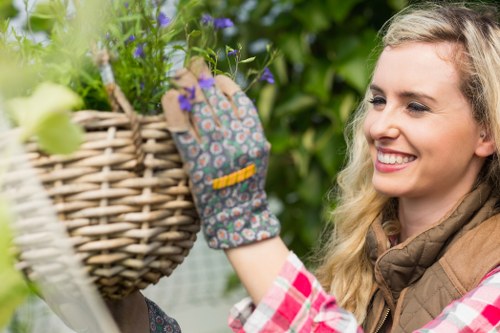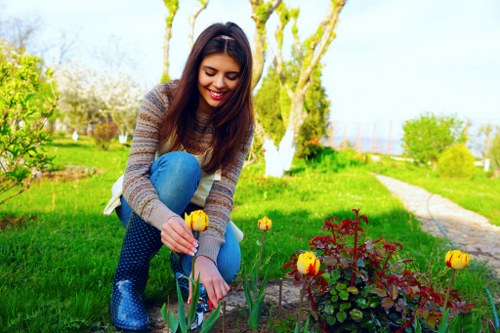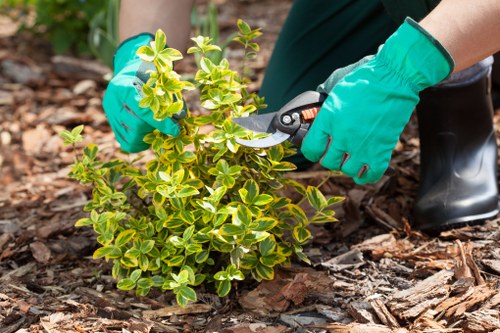Landscape Gardening in Hampstead

Hampstead, renowned for its picturesque streets and historic charm, offers a unique canvas for landscape gardening enthusiasts. Whether you’re a seasoned gardener or a beginner, the diverse climate and soil conditions in Hampstead provide ample opportunities to create stunning outdoor spaces.
Embracing landscape gardening in Hampstead means blending natural beauty with thoughtful design. From traditional English gardens to modern minimalist landscapes, the possibilities are endless. This guide explores the best practices, plant selections, and design ideas to help you transform your Hampstead garden into a personal sanctuary.
Understanding the local climate is crucial for successful landscape gardening. Hampstead experiences a temperate climate with mild summers and cool winters, making it ideal for a wide variety of plants. By selecting flora that thrives in these conditions, you can ensure a vibrant and sustainable garden year-round.

Design Principles for Hampstead Gardens
Creating a harmonious garden in Hampstead involves adhering to key design principles. These include balance, contrast, harmony, and scale. **Balance** ensures that the garden feels stable and visually appealing, while **contrast** adds interest through variations in color, texture, and form.
Harmony is achieved by selecting plants and materials that complement each other, creating a cohesive look. Scale refers to the proportion of elements within the garden, ensuring that plants and structures are appropriately sized for the space available.
Implementing these principles helps in crafting a garden that not only looks beautiful but also feels comfortable and inviting. Additionally, considering the flow and functionality of the space ensures that the garden serves both aesthetic and practical purposes.
In Hampstead, many gardens incorporate traditional elements such as stone pathways, pergolas, and ornamental plants. These features can be combined with modern touches like sleek outdoor furniture and contemporary sculptures to create a balanced and unique landscape.

Plant Selection for Hampstead Gardens
Perennials and Annuals
Selecting the right mix of perennials and annuals is essential for maintaining color and interest throughout the year. Perennials, such as lavender, echinacea, and hostas, provide long-lasting beauty and require less maintenance once established. Annuals like marigolds, petunias, and geraniums offer vibrant, seasonal blooms that can be changed annually to keep the garden fresh.
Native Plants
Incorporating native plants into your Hampstead garden not only supports local biodiversity but also reduces the need for excessive watering and maintenance. Plants like the English ivy, bluebells, and foxgloves are well-suited to the local environment and provide habitat for native wildlife.
Hardscaping Elements
Hardscaping elements such as patios, walkways, and garden walls play a significant role in landscape gardening. These structures provide functionality and structure, enhancing the overall design. Materials commonly used in Hampstead include natural stone, brick, and timber, which complement the traditional aesthetic of the area.

Sustainable Gardening Practices
Adopting sustainable gardening practices is increasingly important in Hampstead. These practices not only benefit the environment but also contribute to the longevity and health of your garden. Here are some key sustainable strategies:
- Composting: Transform kitchen and garden waste into nutrient-rich compost to improve soil health.
- Rainwater Harvesting: Collect rainwater for irrigation, reducing reliance on municipal water sources.
- Organic Gardening: Use natural fertilizers and pest control methods to maintain a healthy garden ecosystem.
- Native Planting: Incorporate native species to support local wildlife and reduce maintenance needs.
Implementing these practices in your Hampstead garden not only fosters a sustainable environment but also creates a resilient and thriving landscape.

Seasonal Gardening Tips
Spring
Spring is the perfect time to breathe new life into your Hampstead garden. Start by clearing away winter debris and preparing the soil for planting. Early-spring blooms like crocuses and daffodils add vibrant color, while planting vegetable beds can yield a bountiful harvest.
Summer
During the summer months, focus on maintaining your garden through regular watering and pruning. Incorporate heat-tolerant plants such as lavender and sunflowers to withstand the warmer temperatures. Creating shaded areas with pergolas or umbrellas can provide respite from the sun.
Autumn
Autumn brings a rich tapestry of colors to Hampstead gardens. Planting bulbs for next spring, such as tulips and hyacinths, ensures future blooms. Raking fallen leaves and adding mulch helps protect plant roots during the colder months.
Winter
Winter gardening involves protecting sensitive plants from frost and snow. Using protective covers and selecting hardy species like holly and winterberry can add interest even in the colder season. Additionally, planning and designing for the next gardening season keeps your landscape fresh and exciting.
Hiring a Professional Landscape Gardener
While DIY gardening can be fulfilling, hiring a professional landscape gardener in Hampstead offers numerous benefits. Professionals bring expertise in design, plant selection, and maintenance, ensuring that your garden thrives throughout the year.
A professional gardener can help you:
- Design a customized garden plan tailored to your space and preferences.
- Select appropriate plants that suit the local climate and soil conditions.
- Implement sustainable practices for a healthy and eco-friendly garden.
- Provide ongoing maintenance to keep your garden looking its best.
Investing in professional services can transform your Hampstead garden into a stunning outdoor retreat with minimal effort on your part.
Maximizing Small Garden Spaces
Not everyone in Hampstead has access to large garden spaces, but even small areas can be transformed into beautiful landscapes. Here are some tips for maximizing small garden spaces:
- Vertical Gardening: Utilize vertical space with trellises, hanging pots, and wall-mounted planters to grow plants upwards, saving ground space.
- Multi-functional Furniture: Choose garden furniture that serves multiple purposes, such as benches with storage or foldable tables.
- Mirrors and Reflective Surfaces: Incorporate mirrors or reflective surfaces to create the illusion of a larger space.
- Compact Plant Varieties: Select compact or dwarf plant varieties that fit well in smaller containers and spaces.
By implementing these strategies, you can create a lush and inviting garden, regardless of its size.
Creating a Wildlife-Friendly Garden
A wildlife-friendly garden not only enhances the beauty of your Hampstead landscape but also supports local ecosystems. Here are ways to make your garden more inviting to wildlife:
- Bird Feeders and Baths: Install bird feeders and baths to attract various bird species, adding life and movement to your garden.
- Native Plantings: Plant native species that provide food and habitat for local wildlife, including bees, butterflies, and beneficial insects.
- Bee Hotels: Create bee hotels to support solitary bees, which are essential pollinators for many plants.
- Water Sources: Provide a reliable water source, such as a pond or a small fountain, to attract amphibians and insects.
Benefits of a Wildlife-Friendly Garden
Creating a wildlife-friendly garden in Hampstead offers several benefits:
- Enhanced Biodiversity: A diverse garden supports a variety of species, contributing to a balanced ecosystem.
- Natural Pest Control: Beneficial insects and birds help control pests, reducing the need for chemical interventions.
- Pollination: Attracting pollinators like bees and butterflies ensures the reproduction of many flowering plants.
- Educational Opportunities: A wildlife-friendly garden provides a living classroom for learning about local flora and fauna.
By fostering a habitat for wildlife, your Hampstead garden becomes a vibrant and dynamic space.
Incorporating Hard Landscaping Features
Hard landscaping elements are essential for defining spaces, providing structure, and adding visual interest to your garden. In Hampstead, common hardscaping features include:
- Patios and Decks: Create outdoor living areas for dining, relaxation, and entertainment.
- Garden Paths: Use stone, gravel, or brick paths to guide visitors through your garden and connect different areas.
- Water Features: Incorporate ponds, fountains, or waterfalls to add a soothing auditory element.
- Shelters and Pergolas: Provide shade and create focal points with structures like pergolas, gazebos, or arbors.
These features not only enhance the functionality of your garden but also contribute to its overall aesthetic appeal.
Lighting Your Hampstead Garden
Proper lighting can transform your garden, extending its usability into the evening and highlighting key features. Here are some lighting ideas for your Hampstead landscape:
- Pathway Lighting: Illuminate garden paths to ensure safety and add a welcoming glow.
- Accent Lighting: Highlight specific plants, sculptures, or architectural elements with focused lighting.
- Ambient Lighting: Create a warm and inviting atmosphere with soft ambient lights, such as string lights or lanterns.
- Solar Lighting: Use solar-powered lights for an eco-friendly and cost-effective lighting solution.
Strategically placed lighting can enhance the beauty of your garden while providing practical benefits.
Maintaining Your Hampstead Garden
Regular maintenance is key to keeping your landscape garden in Hampstead healthy and vibrant. Here are essential maintenance tasks:
- Pruning: Regularly prune trees and shrubs to promote healthy growth and maintain desired shapes.
- Weeding: Remove weeds promptly to prevent them from competing with your plants for nutrients and water.
- Mulching: Apply mulch to retain soil moisture, regulate temperature, and suppress weed growth.
- Irrigation: Ensure your garden receives adequate water, considering both rainfall and manual watering as needed.
- Fertilizing: Provide necessary nutrients to your plants through appropriate fertilization methods.
Consistent maintenance practices ensure that your Hampstead garden remains a beautiful and thriving outdoor space.
Choosing the Right Tools and Equipment
Having the right tools and equipment is essential for effective garden maintenance. Some must-have tools for landscape gardening in Hampstead include:
- Hand Tools: Pruners, spades, trowels, and hoes are fundamental for various gardening tasks.
- Power Tools: Lawn mowers, hedge trimmers, and leaf blowers can help manage larger spaces efficiently.
- Watering Equipment: Hoses, sprinklers, and watering cans ensure your plants receive adequate moisture.
- Protective Gear: Gloves, hats, and sturdy footwear protect you while working in the garden.
- Storage Solutions: Organize your tools with sheds, racks, or storage benches to keep your garden tidy.
Investing in quality tools and maintaining them properly enhances your gardening experience and makes maintenance tasks easier.
Personalizing Your Garden Space
Your Hampstead garden should reflect your personal style and preferences. Here are ways to personalize your outdoor space:
- Garden Art: Incorporate sculptures, murals, or decorative pieces to add character and uniqueness.
- Seating Areas: Create cozy spots with benches, hammocks, or outdoor sofas for relaxation and socializing.
- Themed Gardens: Design sections of your garden around specific themes, such as a herb garden, a butterfly garden, or a Zen space.
- Color Schemes: Choose a color palette that resonates with you, using plants and accessories to bring it to life.
- Water Elements: Add ponds, fountains, or small streams to bring movement and tranquility to your garden.
Incorporating Personal Touches
Personal touches make your garden uniquely yours. Consider adding family heirlooms, handmade decorations, or DIY projects that showcase your creativity and personality.
Conclusion
Landscape gardening in Hampstead offers endless possibilities for creating beautiful and functional outdoor spaces. By understanding design principles, selecting appropriate plants, and implementing sustainable practices, you can cultivate a garden that not only enhances your home but also contributes to the local ecosystem.
Whether you’re looking to maximize a small garden space, create a wildlife-friendly environment, or personalize your landscape with unique features, Hampstead provides the perfect setting to bring your gardening dreams to life.
Ready to transform your Hampstead garden? Contact us today to book your landscape gardening service and start creating the outdoor space you’ve always envisioned.